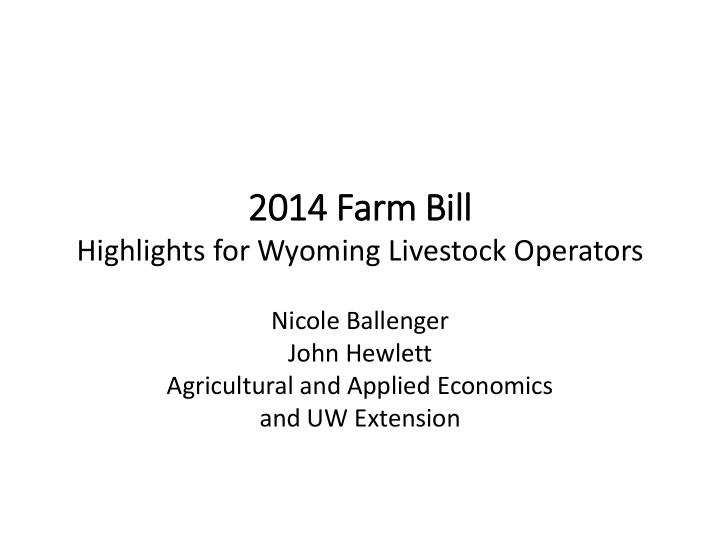



2014 Farm Bill Highlights for Wyoming Livestock Operators Nicole Ballenger John Hewlett Agricultural and Applied Economics and UW Extension
Background • Real name is The Agricultural Act of 2014 – discussion started in 2011, 2008 law extended – signed into law February 2014 • Haggling over budget cuts, gov’t role, program design (from philosophy to micro management) – House wanted much larger SNAP cuts than the Senate (the final result is closer to the Senate proposal) – the final hold up: Boehner (OH) and Peterson (MN) dispute over whether the new dairy program should include a supply control feature (it doesn’t)
Title Title Name Purpose Price or revenue protection for growers of program crops I Commodities Retirement of cropland for conservation purposes; support for II Conservation adoption of conservation activities and practices on working lands Food aid, export credit guarantee, and overseas market access III Trade SNAP (formerly known as food stamps), commodity distribution IV Nutrition Farm ownership and operating loans V Credit Small business loans, housing loan guarantees, water management VI Rural projects, rural electrification and rural broadband investments, Development distance learning and telemedicine Agricultural research and extension at Land Grant universities, and VII Research & identification of national research priorities Extension Forest health initiatives VIII Forestry Investments in alternative energy technology and production of IX Energy renewable biomass for biofuels Specialty crop promotion, including organic, local food, and farmers X Horticulture market activities Subsidized crop insurance to protect against losses due to price and XI Crop Insurance yield risk Examples: Livestock health and marketing programs; support for XII Miscellaneous socially disadvantaged and limited-resource producers
Highlights of changes Or: Is anything really any different this time around? • Commodity support programs are different BUT just as complex, or maybe more so • Conservation programs are not so different BUT there is a significant shift in emphasis • Food assistance (SNAP) was cut BUT not nearly as much as desired by some • Subsidized crop insurance was expanded..alot BUT conservation compliance now required to qualify for premium subsidies!
Budget outlook refle lects changes Original Senate House Area 2014-2023 Agricultural Act of 2014 Proposal Proposal Baseline (change in $ (change in (change in ($ billions) ($ billions) billions) $ billions) $ billions) Commodities $58.8 -$17.4 -$18.7 -$14.3 $44.5 Crop Insurance $84.1 +$5.0 +$8.9 +$5.7 $89.8 Conservation $61.6 -$3.5 -$4.8 -$4.0 $57.6 Nutrition (SNAP) $764 -$3.9 -$39.0 -$8.0 $756 Other Titles $4.0 +$1.9 +1.7 +$4.1 $8.1 Total $973 -$17.9 -$51.9 -$16.5 $956
Implications for Wyoming Livestock Operators • Conservation program changes • Disaster assistance program changes • Other – Beginning farmer and rancher – Biofuel programs?
Conservation Program Changes Portfolio of programs streamlined, programs shifted around, emphasis shifted to working lands • Smaller CRP (cap reduced) Implications for emergency haying and grazing? • Farm and Ranch Land Protection program repealed, replaced with Agricultural Conservation Easement Program (ACEP) Lower funding level • Bigger role for NRCS working lands programs (EQIP and CSP) Offer cost share (up to 75%), incentive payments, and technical assistance for various conservation practices
Working Lands Programs Budget Authority (BA) and Outlays (OL) 2,000 1,800 1,600 1,400 1,200 $ Millions 1,000 800 600 400 200 0 2008 2010 2012 2014 2016 2018 EQIP(+WHIP) BA CSP BA EQIP(+WHIP) OL CSP OL Source: USDA-NRCS and Congressional Budget Office Data file: ag value added – nebraska and us.xlsx
NRCS Obligations in in Wyoming, g, FY2012 • Total technical and financial assistance obligations of $59.2 million • EQIP obligations = $18.7 million • Farm and Ranchland Protection (easement) obligations = $15.8 million • CSP obligations = $8.5 million
Wyoming Land Units Receiving NRCS conservation program benefits by conservation practice type, 2012 Conservation Practice Type Acres Treated Number of Practices Cropland Soil Quality 109,004 1,016 Fish and Wildlife Habitat 448,845 861 Forest Land Conservation 8,179 19 Grazing Land Conservation 1,122,240 1,176 Irrigation Efficiency 69,159 701 Water Quality 549,556 2,005 Wetlands 10,279 33 Source: USDA Natural Resources Conservation Programs, NRCS Conservation Programs http://www.nrcs.usda.gov/Internet/NRCS_RCA/reports/cp_wy.html
Most popular NRCS-supported grazing la land conserv rvation practices, fy fy2012 • Brush management • Fencing • Integrated pest management • Livestock pipeline • Prescribed grazing • Pumping plant • Water well • Watering facility
Recommend
More recommend